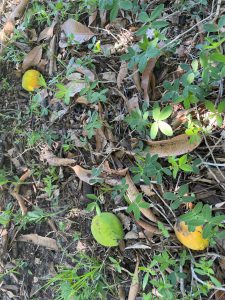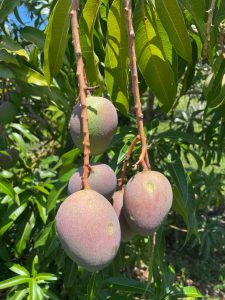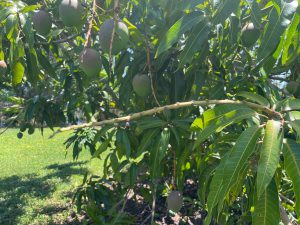And the short answer is; yes, it’s normal.

Usually this time of the year, mangos start dropping their small fruit when there is more fruit on the tree than can continue on to maturity. The number of fruits that set and mature on a mango tree is very small in relation to the number of flowers produced by the tree. Most varieties in Florida produce an average of less than one fruit per panicle.

Why does this happen?
There are many reasons why mangos drop their fruit. A mango tree can only handle so much fruit depending on nutrients, climate, water, variety and many other factors. Below are some reasons why you might see fruit drop in your grove:

- Too little feeding or overfertilizing can cause fruit drop.
- Variety: some trees bear heavier every other year. Most varieties in Florida produce an average of less than one fruit per panicle. Some mango varieties produce small fruit but the seed’s embryo never develops and fruit is dropped when it is small.
- Anthracnose, powdery mildew, and low temperatures along with heavy dew during bloom generally reduce fruit set. One to two early spring applications of sulfur and copper timed to begin when the panicle is 1/4 full size and then 10 to 21 days later will greatly improve the chances for fruit set and production. Timely application and thorough application are important.
- Too much water can also lead to fruit drop. Little to no irrigation is generally necessary during the fall and winter. Once the rainy season arrives, irrigation frequency may be reduced or stopped.
- This year’s problem may be entirely caused by conditions out of your control such as climate, temperatures, and rainfall. Impacts from Hurricane Ian, especially in coastal Collier County could have added stress to trees. Sometimes extreme stress can cause delaying blooms, sometimes skipping a blooming year altogether, or poor fruit set with increased fruit drop. We also saw cold temperatures in inland Collier County during blooming and fruit set, which could add to premature fruit drop.
For more information on mangos, check out the factsheet at this link: https://edis.ifas.ufl.edu/publication/MG216
Note: All images and contents are the property of UF/IFAS.
Source: UF/IFAS Pest Alert



